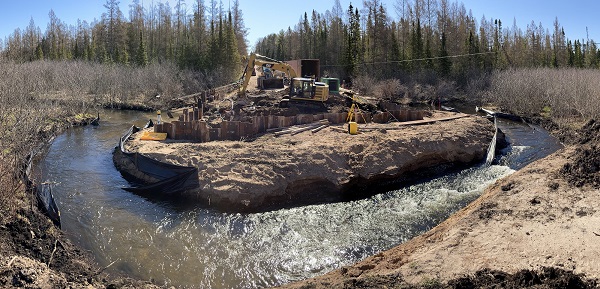Project to correct Black River crossing
Last major hurdle to restoring premier brook trout fishery.
LEWISTON —A construction project underway at a river crossing on County Road 622 northwest of Atlanta will correct seasonal flooding and erosion problems and improve connection to 20 miles of the East Branch Black River, the premier brook trout fishery of the Lower Peninsula.
Known locally as the Shingle Mill crossing, the site is where the 26-foot-wide East Branch flows under County Road 622 through a 9-foot-diameter pipe culvert. During times of high water, the river floods over the roadway, leading to recurring safety and maintenance concerns for the road commission and causing harmful erosion and sediment issues for the river.
Workers will replace that undersized pipe culvert with a 27-foot bottomless arch culvert, designed to let the river flow naturally beneath the crossing even at flood stage. The pipe culvert was removed earlier this month and the stream channel has been temporarily diverted around the work site where concrete footings to support the new arch will be installed in the coming weeks.
Total project cost is about $370,000 and is being managed by Huron Pines with funding from the U.S. Fish and Wildlife Service National Fish Passage and Partners for Fish and Wildlife programs, Walters Family Foundation, and the Montmorency County Road Commission
County Road 622 will be closed to thru traffic for the duration of the project, which is expected to wrap up in mid-June. The crossing is located about halfway between Vienna Corners and M-33.
Josh Leisen is Senior Project Manager for Huron Pines, the regional nonprofit conservation agency overseeing the work.
“There was a risk of a complete road washout as long as that old culvert remained, which would have been a safety hazard and major inconvenience for traffic flow and an expensive fix for the road commission,” Leisen explained. “Sediment from erosion is also a pollutant to the river because it buries crucial spawning habitat and the high flows through that culvert created fish passage concerns at certain times of the year.”
The Upper Black River originates in the Pigeon River Country State Forest and is the only stream in the Lower Peninsula managed exclusively for native brook trout, Michigan’s state fish prized by anglers.
Tim Cwalinski is a biologist and represents the Department of Natural Resources’ Fisheries Division on the Upper Black River Council, a committee of government agencies, landowners, user groups and conservation organizations steering projects to improve the watershed. This site was on their radar for more than two decades.
“The East Branch doesn’t have too many scars but this was one of them and it was time to replace it,” Cwalinski said. “This is one of our highest quality trout streams in the Northern Lower (Peninsula) and we want to make sure it stays healthy for another 50 years.”
Additional partners for the project include Huron Engineering and Surveying, Inc., MacArthur Construction and the Upper Black River Council.
###
and Up North Voice are Northern Michigan’s source for community news.
We are also a full-service commercial design and printing house. Our specialty is custom commercial printing, as well as the creation of clothing, cups and other marketing products.
To submit information for publication, or for questions regarding promotion of your business, please email .
Up North Voice is a division of AuSable Media Group, LLC, based at 709 Lake Street in Roscommon




